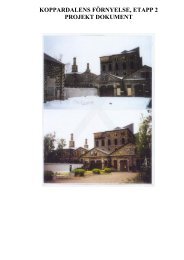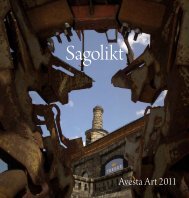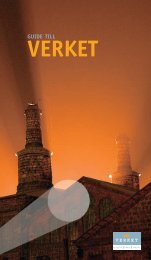Avesta Art 2010 - Verket
Avesta Art 2010 - Verket
Avesta Art 2010 - Verket
- TAGS
- avesta
- verket
- www.verket.se
Create successful ePaper yourself
Turn your PDF publications into a flip-book with our unique Google optimized e-Paper software.
Andreas Charalambous<br />
- Ingen konstnär kan arbeta oberörd av sitt samhälle och sin samtid<br />
Konsten är alltid ett uttryck ur konstnärens liv och speglar därmed både<br />
omvärlden och konstnärens eget förhållningssätt Som konstnär tillfogar<br />
jag filosofiska frågor och estetiska värden som gör att andra med nya ögon<br />
kan se på sin situation – och dess hot och möjligheter<br />
Andreas Charalambous är född på Cypern och utbildad vid Konstakademien<br />
Sourikof i Moskva, där han sedan verkade som assisterande<br />
professor med muralmålningar som specialitet Sedan trettio år är han<br />
ånyo bosatt på Cypern Han har gått sin egen väg i en konstnärsgärning<br />
med stor internationell räckvidd Han driver också en egen konstskola i<br />
Nicosia och har 1983 arbetat som gästande lektor vid The Pratt Institute i<br />
New York 2007 blev han hedersmedlem av Konstakademien i Ryssland<br />
Tre teman finns i Charalambous medverkan i <strong>Avesta</strong> <strong>Art</strong>: Antik<br />
mytologi genom målningen ”Våldtäkten på Europa” – ett verk om den<br />
europeiska civilisationens begynnelse<br />
Cypernproblemet Tre målningar med kaffekoppar uttrycker ironi och<br />
sarkasm med anknytning till den nationalism, som är rot till tragedin på<br />
“No artist can work untouched by the society or age in<br />
which he lives <strong>Art</strong> is always an expression of the<br />
artist’s life and therefore reflects both the world<br />
around and the artist’s own point of view As an artist<br />
I add philosophical issues and aesthetic values so<br />
that others can see their situation – its threats and<br />
opportunities – with new eyes ”<br />
Andreas Charalambous was born in Cyprus and<br />
studied at the Sourikof Academy of <strong>Art</strong> in Moscow<br />
where he then worked as an assistant professor of<br />
painting specialising in murals He returned to Cyprus<br />
thirty years ago He studied classical painting and has<br />
chosen his own path in his artistic work on a large<br />
international scale He also runs his own school of art<br />
in Nicosia He worked as a visiting lecturer at the Pratt<br />
Institute of New York in 1983 In 2007, he became an<br />
honorary member of the Russian Academy of <strong>Art</strong><br />
The focus in <strong>Avesta</strong> is on three aspects:<br />
Ancient mythology with “The Rape of Europe”,<br />
a work about the beginning of the civilization of<br />
Europe The Cyprus problem The irony and sarcasm<br />
of the coffee triptych makes a mockery of nationalism,<br />
which is the beginning of the tragedy and division of<br />
Cyprus Something as unimportant as a cup of coffee<br />
can become the source of strong national feelings and<br />
pride The humour lies in the fact that coffee is neither<br />
Turkish nor Greek, but Ethiopian (Photo at page 4 )<br />
The three works from the series “Travacounta Cypria”,<br />
where a stony landscape in North Cyprus inspired the<br />
artist to speak with eroticism and humour, are about<br />
the different influences on the people of Cyprus –<br />
from pre-historical and ancient times, through the<br />
destruction, and finally to the hope of an united Cyprus<br />
The Swedish works Charalambous has a long<br />
relationship with Sweden and Swedish culture In<br />
1988, he made the sets and costumes for the<br />
children’s performance of “Carlson on the roof” by<br />
Astrid Lindgren at the state theatre of Cyprus In 1992,<br />
Cypern och delningen av landet Något så enkelt som en kopp kaffe kan<br />
väcka stark nationell känsla och stolthet Det är skrattretande eftersom<br />
kaffet varken är turkiskt eller grekiskt, det är etiopiskt (Foto på sid 4 ) I tre<br />
verk från serien ”Travacounta Cypria” har ett stenigt landskap inspirerat<br />
konstnären till ett erotiskt och humoristiskt formspråk Verken berör olika<br />
influenser på cyprioterna – förhistorisk och antik tid, delningen av landet<br />
och hoppet om ett enat Cypern<br />
De svenska verken Andreas Charalambous har en lång relation till<br />
Sverige och till svensk kultur Han har gjort scenografi och scenkläder till<br />
både ”Karlsson på taket” och ”Fadren” De två teaterstudierna i <strong>Avesta</strong><br />
<strong>Art</strong> är rekonstruerade i år De första verken brann 2006 när en eldsvåda<br />
i konstnärens ateljé förstörde mer än 1700 av hans verk Han har även<br />
arbetat med konstnärer i Gällivare och ställt ut tillsammans med Olle<br />
Martinsson 1999 deltog han i pancypriotisk workshop på Gotland där han<br />
också har ställt ut Vid sitt första besök i <strong>Avesta</strong> i december 2009 tecknade<br />
Charalambous mycket Med inspiration från teckningarna har han målat<br />
de fem <strong>Avesta</strong>landskap som nu visas i <strong>Avesta</strong> <strong>Art</strong> (Foto på sid 41 )<br />
8<br />
he made the same for the play “The Father” by<br />
August Strindberg at Theatro Ena in Nicosia The two<br />
theatrical studies in the <strong>Avesta</strong> exhibition are recreated<br />
in <strong>2010</strong> The first studies were burnt in 2006,<br />
when a fire in the studio of the artist destroyed more<br />
than 1700 of his works As a result the costumes of<br />
the two plays are shown in saved photos<br />
In 1993, Charalambous worked for three weeks in<br />
an art colony in Gällivare In 1996, he took part in a<br />
two-man exhibition in Nicosia: “Cyprus of a Swedish<br />
artist Olle Martinsson and Sweden of Andreas<br />
Charalambous ” In 1999, he participated in an artistic<br />
workshop in Visby at Gotland with other Cypriote<br />
artists and in 2003, in an exhibition in Visby with<br />
Emin Cizenel<br />
Now <strong>Avesta</strong> He made a lot of drawings on his<br />
first visit in December 2009 From the drawings he<br />
painted the five <strong>Avesta</strong> landscapes, they are on show<br />
in the <strong>Avesta</strong> <strong>Art</strong> (Photo at page 41 )







